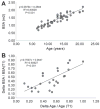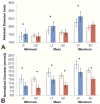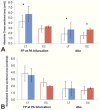Fontan pathway growth: a quantitative evaluation of lateral tunnel and extracardiac cavopulmonary connections using serial cardiac magnetic resonance
- PMID: 24444876
- PMCID: PMC3952493
- DOI: 10.1016/j.athoracsur.2013.11.015
Fontan pathway growth: a quantitative evaluation of lateral tunnel and extracardiac cavopulmonary connections using serial cardiac magnetic resonance
Abstract
Background: Typically, a Fontan connection is constructed as either a lateral tunnel (LT) pathway or an extracardiac (EC) conduit. The LT is formed partially by atrial wall and is assumed to have growth potential, but the extent and nature of LT pathway growth have not been well characterized. A quantitative analysis was performed to evaluate this issue.
Methods: Retrospective serial cardiac magnetic resonance data were obtained for 16 LT and 9 EC patients at 2 time points (mean time between studies, 4.2 ± 1.6 years). Patient-specific anatomies and flows were reconstructed. Geometric parameters of Fontan pathway vessels and the descending aorta were quantified, normalized to body surface area (BSA), and compared between time points and Fontan pathway types.
Results: Absolute LT pathway mean diameters increased over time for all but 2 patients; EC pathway size did not change (2.4 ± 2.2 mm vs 0.02 ± 2.1 mm, p < 0.05). Normalized LT and EC diameters decreased, while the size of the descending aorta increased proportionally to BSA. Growth of other cavopulmonary vessels varied. The patterns and extent of LT pathway growth were heterogeneous. Absolute flows for all vessels analyzed, except for the superior vena cava, proportionally to BSA.
Conclusions: Fontan pathway vessel diameter changes over time were not proportional to somatic growth but increases in pathway flows were; LT pathway diameter changes were highly variable. These factors may impact Fontan pathway resistance and hemodynamic efficiency. These findings provide further understanding of the different characteristics of LT and EC Fontan connections and set the stage for further investigation.
Copyright © 2014 The Society of Thoracic Surgeons. Published by Elsevier Inc. All rights reserved.
Figures







Comment in
-
Invited commentary.Ann Thorac Surg. 2014 Mar;97(3):922-3. doi: 10.1016/j.athoracsur.2014.01.016. Ann Thorac Surg. 2014. PMID: 24580909 No abstract available.
Similar articles
-
Energetic implications of vessel growth and flow changes over time in Fontan patients.Ann Thorac Surg. 2015 Jan;99(1):163-70. doi: 10.1016/j.athoracsur.2014.08.046. Epub 2014 Nov 20. Ann Thorac Surg. 2015. PMID: 25440274
-
Postsurgical comparison of pulsatile hemodynamics in five unique total cavopulmonary connections: identifying ideal connection strategies.Ann Thorac Surg. 2013 Oct;96(4):1398-1404. doi: 10.1016/j.athoracsur.2013.05.035. Epub 2013 Jul 30. Ann Thorac Surg. 2013. PMID: 23910632
-
Computational fluid dynamics in the evaluation of hemodynamic performance of cavopulmonary connections after the Norwood procedure for hypoplastic left heart syndrome.J Thorac Cardiovasc Surg. 2003 Oct;126(4):1040-7. doi: 10.1016/s0022-5223(03)00698-6. J Thorac Cardiovasc Surg. 2003. PMID: 14566244
-
Extracardiac conduit variation of the Fontan procedure.Adv Card Surg. 2000;12:175-98. Adv Card Surg. 2000. PMID: 10949650 Review.
-
Extracardiac conduit Fontan procedure versus intra-atrial lateral tunnel Fontan procedure.Gen Thorac Cardiovasc Surg. 2012 Dec;60(12):792-5. doi: 10.1007/s11748-012-0161-9. Epub 2012 Oct 18. Gen Thorac Cardiovasc Surg. 2012. PMID: 23229999 Review.
Cited by
-
Evolving hemodynamics in Fontan circulation: age-driven insights in patients with interrupted inferior vena cava and hepatoazygos shunt.Am J Physiol Heart Circ Physiol. 2025 Jul 1;329(1):H124-H134. doi: 10.1152/ajpheart.00072.2025. Epub 2025 May 5. Am J Physiol Heart Circ Physiol. 2025. PMID: 40323666 Free PMC article.
-
Semi-Automatic Planning and Three-Dimensional Electrospinning of Patient-Specific Grafts for Fontan Surgery.IEEE Trans Biomed Eng. 2022 Jan;69(1):186-198. doi: 10.1109/TBME.2021.3091113. Epub 2021 Dec 23. IEEE Trans Biomed Eng. 2022. PMID: 34156934 Free PMC article.
-
Long-Term Serial Follow-Up of Pulmonary Artery Size and Wall Shear Stress in Fontan Patients.Pediatr Cardiol. 2016 Apr;37(4):637-45. doi: 10.1007/s00246-015-1326-y. Epub 2016 Jan 12. Pediatr Cardiol. 2016. PMID: 26757738 Free PMC article.
-
Novel lateral tunnel Fontan operation in children promotes continued pathway growth into adulthood.JTCVS Tech. 2024 Oct 16;29:138-145. doi: 10.1016/j.xjtc.2024.09.025. eCollection 2025 Feb. JTCVS Tech. 2024. PMID: 39991315 Free PMC article.
-
Extracardiac conduit adequacy along the respiratory cycle in adolescent Fontan patients.Eur J Cardiothorac Surg. 2022 Jun 15;62(1):ezab478. doi: 10.1093/ejcts/ezab478. Eur J Cardiothorac Surg. 2022. PMID: 34747442 Free PMC article.
References
-
- de Leval MR, et al. Total cavopulmonary connection: a logical alternative to atriopulmonary connection for complex Fontan operations. Experimental studies and early clinical experience. J Thorac Cardiovasc Surg. 1988;96(5):682–95. - PubMed
-
- Stamm C, et al. Long-term results of the lateral tunnel Fontan operation. Journal of Thoracic and Cardiovascular Surgery. 2001;121(1):28–41. - PubMed
-
- Tokunaga S, et al. Total cavopulmonary connection with an extracardiac conduit: experience with 100 patients. Ann Thorac Surg. 2002;73(1):76–80. - PubMed
-
- Chowdhury UK, et al. Specific issues after extracardiac fontan operation: ventricular function, growth potential, arrhythmia, and thromboembolism. Ann Thorac Surg. 2005;80(2):665–72. - PubMed
-
- Khairy P, Poirier N. Is the extracardiac conduit the preferred Fontan approach for patients with univentricular hearts? The extracardiac conduit is not the preferred Fontan approach for patients with univentricular hearts. Circulation. 2012;126(21):2516–25. discussion 2525. - PubMed
Publication types
MeSH terms
Grants and funding
LinkOut - more resources
Full Text Sources
Other Literature Sources
Medical

